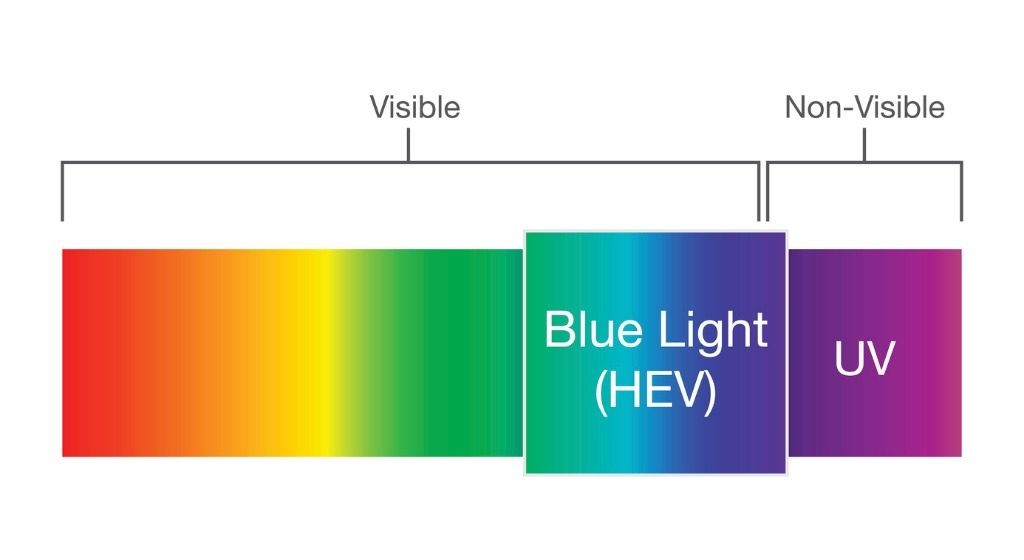
With more of our lives happening via a screen – socialising, work, entertainment, our daily screen-time has peaked dramatically. Technology is definitely on our gratitude list. We’re thankful for the connection it gives us to the world and our fellow humans. Along with the positives, more screen time exposes our eyes and skin to extra blue light damage. It’s not an ideal recipe for healthy skin – or eyes!
There’s a stack of published research on it – ‘blue light hazard’ is a popular scientific term. So, it’s a real thing. Your optometrist or beauty therapist might have mentioned it - your eyes and skin need protection from oxidative damage and degeneration caused by blue light.
Thankfully, there are plenty of ways to protect ourselves - more on this later.
How it happens
Like UVA and UVB rays, HEV (high energy visible light) is another type of light ray emitted by the sun. Commonly known as blue light, HEV light makes up the blue portion of visible light. It’s one of the shortest and highest energy wavelengths in in the electromagnetic spectrum.

It comes from the sun, but blue light is also emitted artificially from devices like computers, phones, tablets and TVs.
While most of us are aware of the damage that UVA and UVB rays can do, more evidence is emerging of the harmful effects HEV blue light can also have.
Artificial blue light is not the same intensity as the sun. But over time, daily exposure is cumulative. Although there is no evidence of HEV light causing skin cancer, it’s still worth protecting yourself to avoid long-term damage.
Research shows that blue light causes oxidation, damage and degeneration. Due to its wavelength, it penetrates the deeper layers of our skin and eyes.
Signs of oxidation
- Fine lines and wrinkles
- Age spots or dark patches
- Loss of skin volume – less firm appearance
- Eye fatigue and age-related degeneration
Oxidation is the normal process that causes wear and tear in the body. It happens every day.
Oxidation is the process that makes us age
Certain things can speed up oxidation.
- Being stressed long term
- Too much alcohol
- Not enough sleep
- Artificial blue light exposure
- Too much sun exposure
No one’s perfect - we’ve all woken up to see a slightly-worse-for-wear look in the mirror. This is visible oxidation.
How can we protect ourselves?
1. Limit things on the list above.
Be aware of avoidable things that increase oxidation - they speed up normal wear and tear on our cells.
2. Use a broad-spectrum sunblock.
A quality, zinc oxide-based sunblock protects against UVA, UBA and HEV rays. It works by reflecting light away from the skin. Make it part of your morning routine.
We stock a range of natural SPF sunscreens for Face for you to choose from.
3. Wear glasses with blue blocker lenses.
To protect your eyes, you can get blue light blocking lenses for your glasses. This helps to reduce eyestrain and degeneration.
4. Use a filter on your device.
Most cumputers and all iOS devices have a built-in blue light filter to limit emission. You'll find 'night mode' or 'night shift' in the settings menu. Or, you can install a filter app, Twilight is popular for Android.
5. Eat a fruit & vege rainbow.
For antioxidants that protect us from damage - the brighter the better. They’re found at higher levels in the peel, so try washing rather than peeling. All that fibre in the skin helps with toxin clearing too.
4. Up your antioxidants.
Plant derived antioxidants are very bioavailable – easy for our bodies to recognise and use. They support healthy protection against oxidation.
Grapeseed extract (Vitis vinifera) contains oligomeric proanthocyanidins (OPCs) - plant antioxidants with special affinity for the skin and eyes, have a look at Solgar Grape Seed Extract.
Antioxidant-rich plants like Blackcurrant (Ribes nigrum), Ginkgo (Ginkgo biloba) and Calendula (Calendula officinalis) help boost your intake. You’ll find them in BioBalance Crystal Vision, specially formulated to help with blue light exposure.

